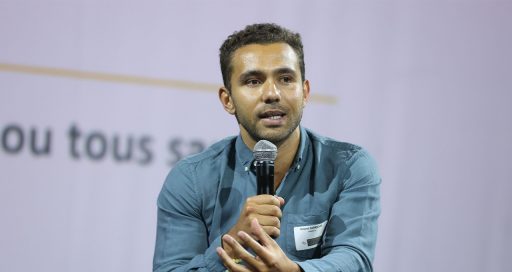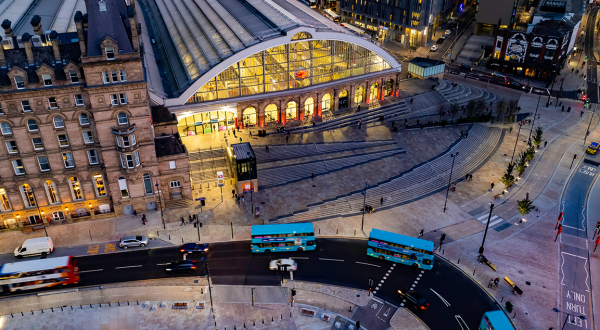They continue to increase in number and are becoming increasingly diversified, but are urban artificial intelligences succeeding where the smart city has failed? For Hubert Beroche, director of the think tank Urban AI, we still need to understand its uniqueness and complexity, and organise its governance.

©ADI
What has shaped your thinking and actions in the field of urban artificial intelligence?
Hubert Beroche: In 2019, I set off to explore the world of AI applications in urban environments. From this investigative work, during which I studied the reality of AI developments in twelve cities on three continents, I drew two initial conclusions, namely that AI developments are proliferating massively and also diversifying.
Artificial intelligence in towns and cities was initially embodied in smart city projects. Then, with the emergence of ChatGPT and the reduced price of entry to algorithm technologies, multiple stakeholders have been driving the gradual proliferation of applications.
How do you define urban artificial intelligence?
H.B.: From this initial proliferation and diversification, another, even more crucial, factor has emerged: the uniqueness of urban AI. AIs are born and developed in virtual environments (social networks, streaming platforms, etc.) or closed, private environments (businesses, factories, etc.). The city is by definition a physical, open space. Unlike other AIs – I’m thinking for example of trading algorithms or recommendations on e-commerce sites – the existence of urban AIs is expressed in materiality, embodiment, a grounding in the physical world and our day-to-day life. From drones to sensors to connected terminals, these instruments used to control, map and supply our systems are eminently visible. This simple fact of their elementary appearance – the physicality of urban AIs – has had huge repercussions on the way these technologies are developed, governed and implemented. To give one example: an error from Waze can quickly lead to traffic jams.
In that context, what has become of the smart city concept?
H.B.: The smart city did not work because people rejected it, either explicitly or simply by not adopting the applications. But the narrative around the smart city is still relevant.
“The narrative around the smart city is still relevant.”
More precisely, there are two main narratives. One is driven by high-technology businesses and North American government agencies, promising a city optimised by technology and citizen well-being contingent on access to services essentially provided by private entities. We should note that this narrative has seriously waned in influence since the Sidewalk Labs project in Toronto was abandoned.
And the other narrative?
H.B.: The other vision is the one China is seeking to impose, that of a safe and secure world, in which urban technologies are the vehicles and regulators of social and political order.
Between the American techno-solutionist vision and the Chinese techno-security narrative, there are questions we need to ask. What alternative narrative can we offer? What kind of AI do we want in and for our urban environments? What urban AIs do we collectively want? This is an area we are actively investigating at Urban AI and alongside several international partners with our Global Observatory of Urban AI Narratives.
So, how do we answer these questions?
H.B.: First, we must understand what urban AI is. Contrary to what our spontaneous representations often suggest, it cannot be reduced to sensors on one hand and dashboards on the other. It feeds complex systems composed of multiple layers, owned and used by a hugely diverse range of stakeholders to serve different – often divergent – interests. Understanding the systemic dimension and architecture of urban AI is a prerequisite for controlling and regulating these technologies.
Is governance not key here?
H.B.: It is crucial. If we want to implement considered policies that take account of local cultures, are based on constructed visions, and mobilise identified skills and resources, we absolutely must think about governance. AI is not an end in itself. It must be an instrument in the service of a political vision and action, of an urban social contract.
Today, AIs are increasingly being used locally in energy, waste management and architecture. They are helping us understand urban dynamics, map mobility patterns and organise logistical flows. In short, to optimise the urban fabric. But all that supposes that we are involving, uniting and organising the presence and roles of the maximum number of local stakeholders, public and private, individual and corporate, in this technological expansion.
Should we not establish certain principles right from the application design stage?
H.B.: The physical presence of urban AIs is not given sufficient consideration in their design. One example that will speak to everyone is the omnipresence of smartphone screens. These interfaces have so absorbed our attention that they have concealed our presence in the city.
We are becoming “smombies” – a portmanteau of “smartphone” and “zombie”. This neologism, which is central to my book Smombies, la ville à l’épreuve des écrans(*) [Lit: Smombies – screen-proofing the city], refers to those people who are constantly looking at their phones while walking, while driving, to the point they are oblivious to the signals the urban environment is sending them. As we know, this blindness causes many accidents. In Seoul, 61% of road accidents involve a pedestrian using a smartphone. The city ended up installing LED panels in the pavement, synchronised with the traffic lights, to give pedestrians the red or green light without their having to look up.
How can we free ourselves from this screen monopoly?
H.B.: By inventing other materialities for urban AIs and digital more broadly. By cultivating alternatives to screens. We can use walls, lights, street furniture and water surfaces to display the more artistic, poetic expressions of AI, in a greener and less energy-intensive way.
Take the Green Cloud in Helsinki, for example. Every evening for a week, a green cloud formed above a thermal power plant in the Finnish capital, the result of a laser projected on the steam emitted from the plant. Each day, the size of the cloud changed to reflect the quantity of energy being consumed by the district’s inhabitants. This sensory experience was virtuous in more ways than one: it delivered data of public interest on a surface other than a screen, and it inspired curiosity and wonder, creating opportunities for discussions and interactions.
“Urbanising AI”
Urban AI brings together an international ecosystem and multidisciplinary community. “Rather than creating smart cities, our ambition is to urbanise artificial intelligence and equip stakeholders accordingly,” explains Hubert Beroche. To this end, the organisation produces books, white papers, trend reports, analyses, and more. It enjoys support from Leonard, the VINCI Group’s future-oriented innovation and acceleration platform. Urban AI also provides consultancy to urban stakeholders, and recently launched a training platform – the Urban AI Academy. Urban AI aims to be a hub for meetings and discussions: “A debating space that welcomes diverse points of view around AI and the future of towns and cities; an ideas laboratory that helps citizens, public decision-makers and businesses grasp the possibilities of Urban AI”.
(*) Editions de l’Aube, 2025.
11/14/2025





